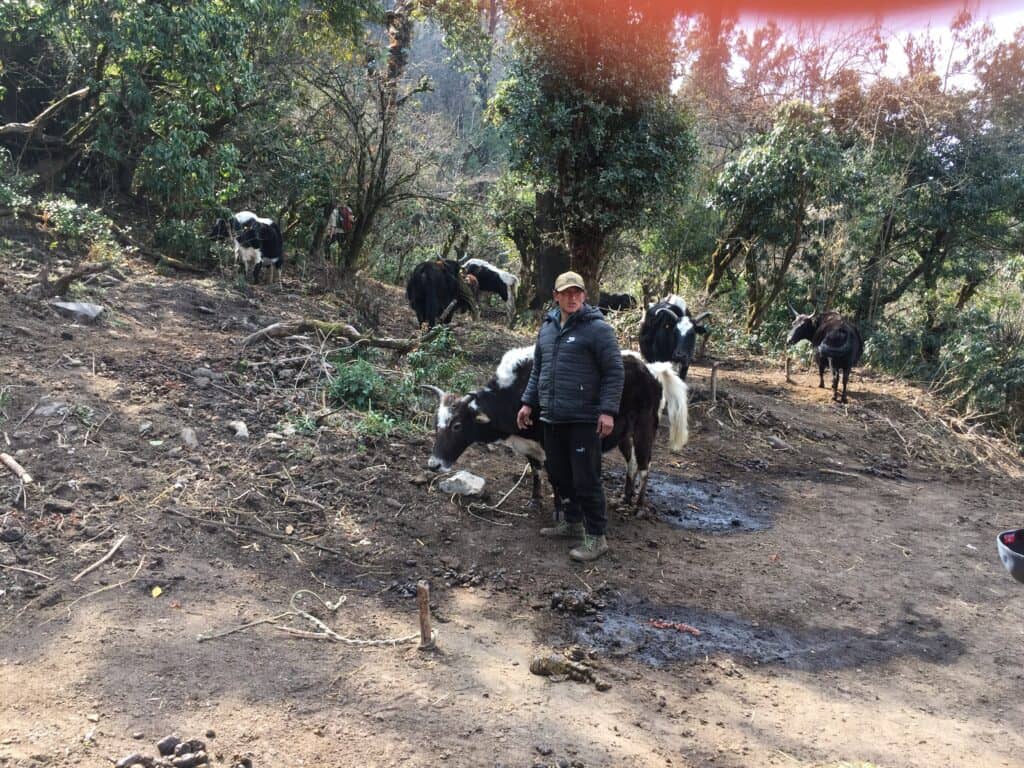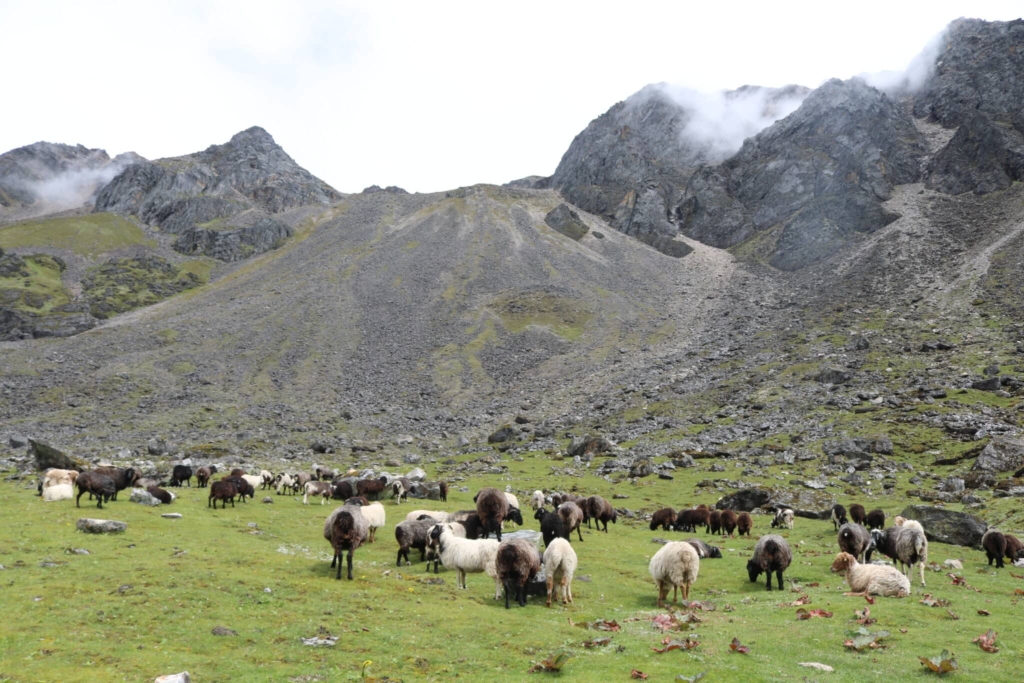In Rasuwa, Nepal, we meet Pasang Norchel Tamang who share his struggles with cattle herding and its effects due to a changing climate. This is the fourth of the “Voices from the Frontline (Phase III)” stories by GRP and ICCCAD supported by Irish Aid.
In the Ammachodingmo Rural Municipality of Rasuwa, Nepal we meet Pasang Norchel Tamang, who has been herding yaks, Chauris, goats and sheep in high alpine pastures for the last 15 years to earn his family’s livelihood.
Aamachodingmo Rural Municipality, located in the northern part of central Nepal is one of the most remote areas of Nepal, which is mainly inhabited by the ethnically marginalized Tamang communities. Most of the communities residing in these areas live below the poverty line and rely heavily on subsistence farming and animal husbandry for their livelihoods. The area is not only economically weak, but it also faces high risks of climate induced and other natural hazards like landslides, soil erosion, earthquakes, forest fires, droughts, cyclones, heat stress, and more. Furthermore, the weak topography and excessive use of land resources for hydropower development have made the communities even more vulnerable and sensitive, pushing them towards higher risks and uncertainties.
Meet Pasang Norchel Tamang

Pasang Norchel Tamang is one of the renowned herders of the area, who lives in Chilime village of Aamachodingmo Rural Municipality of Rasuwa district in Bagmati Province. Mr. Pasang and his family have been engaged in herding for the last 15 years. Until 2015, Pasang was very happy and content with his work as the income was good and grass and water in the pastures were adequate and readily available. His children used to attend school and his income was enough for his family to sustain their lives, celebrate festivals, and have sufficient money for education and health.
However, since 2015 it has rained less and less, which has further led to depletion of water sources in the pastures. According to Mr. Pasang, “In some pastures the sources were completely dried off. With less available water and an increase in temperature in the pastures, the pastures’ productivity went down in terms of both, the quality and quantity of grasses which, in turn, reduces the productivity of cattle and the household income.”
Persisting through a changing climate
Over the last few years, the higher quality grasses in pastures like Nigalo (Drepanostachyum spp.) are dying due to lack of water and increasing heat stress. Despite, the persistent loss in his business, Mr. Pasang is persisting, but struggling to sustain his livelihood since he doesn’t have other alternatives and ideas to start anything new. The production of milk has gone down to half, and the time-interval for new offspring has doubled. The expense for the cattle’s food and medicine has also increased. The grass in the pastures are now insufficient and fulfils only one-third of total demand. “Now, we are spending more than half of our total income to buy hay, maize, wheat, millet and other cereals to feed our cattle,” says Mr. Pasang.
This change in precipitation patterns has contributed to a rise in temperature which has brought an increasing number of challenges in both pastures and in the herders’ life. The water sources of many pastures have now dried up and the productivity of such pastures has declined dramatically. Such pastures are now abandoned and herds are concentrated only in limited pastures with available water resources.
“Once there used to be only 3-4 herds in one pasture, now there are more than 12 herds. More herds means more cattle and more cattle needs more food, but we can hardly find sufficient grasses and bushes to feed the existing herds,” says Mr. Pasang.
Climbing to higher to find my more suitable pastures
The temperature within the area is rising fast and the increase in temperature has forced herders to move their cattle to higher altitude pastures, one month earlier than previously planned. Yaks and Chauris are very sensitive and can’t tolerate even a slight increase in temperature. “It has already been six months, that we have not received a single drop of rain or snow. Because of dramatic rise in temperature this year, there has been miscarriages among many yaks and the Chauris which we had never seen before in our life,” Mr. Pasang added.
The miscarriages have caused huge economic loss. Mr. Pasang is not sure whether it is due to a rise in temperature or less availability of grass causing inadequate food supply. The fertility rate of yaks and Chauris has reduced by half in recent years and now they only reproduce once in the same time period compared to twice in previous years.
Since the productivity of the cattle has decreased by half, Mr. Pasang has now doubled the number of yaks and Chauris to maintain the same income. More cattle need more human resources so both of Mr. Pasang’s sons are working to care for their cattle to support their family business. Even though both sons are interested in continuing their schooling, they were forced to drop out as their father was no longer able to manage expenses for their education. A large portion of Mr. Pasang’s income goes to paying off interest on the loans he has taken to buy more yaks and Chauris. The decline in his income has also impacted Mr. Pasang’s social and cultural life. His family doesn’t have enough money to celebrate different festivals which they used to celebrate earlier.

Additional challenges
Landslides caused by erratic rainfall during monsoon season and the haphazard road constructed by hydropower projects have blocked the way to reach many pastures. The dam constructed by recent hydropower project has fragmented the pastures. The herders need a bridge to cross that dam to reach Syanjen pasture, which is one of the biggest and most productive pastures of the area that holds cattle for almost four months. However, Mr. Pasang worries about how to get his cattle to the pasture as there isn’t a bridge.
In the few pastures where alternative water sources are available nearby, Mr. Pasang brings water through polythene pipes and each time he moves to new pastures he has to take the pipes with him. In the pastures, without nearby alternate water sources, Mr. Pasang collects rainwater in a polythene bags for himself and for his cattle. As the quantity of rainfall is decreasing each year, the amount of rainwater for drinking purposes is not adequate to quench the thirst of cattle.
Besides, feeding hay, cereals and porridge to address the problems of less grass in the pastures, Mr. Pasang also takes his herd to Tibetan grassland for which he has to pay NRs 100 tariff for each yak and Chauri.
Even though Pasang is trying to minimize the losses and damages to his cattle and his livelihood in one way or another, the measures adopted by him are not sufficient and sustainable. The impacts of climate change have affected social, economic, psychological and cultural aspects of his life. If immediate actions are not taken, the impacts will be even worse and will impede the lives of most marginalized, poor and vulnerable groups who are entirely dependent on pastures for their livelihood.
Interviewer’s perspective
Pasang Norchel Tamang’s story is evidence of how climate change is impacting the lives and livelihoods of traditional herders residing in the most remote and inaccessible parts of the world. Many stories of the impacts of climate change on people’s day to day lives remain untold, unheard and unseen. They are now waiting to see what happens next and are struggling hard to survive.
About the interviewer
Umesh Basnet is the senior research coordinator at Portland State University and Research and Development Coordinator at Nepal Water for Health, a non-government organization working to provide safe and sustainable drinking water supply to the under-served communities of Nepal. He has over seven years of experience in conducting climate change, Disaster Risk Reduction (DRR), biodiversity, socio-economic and anthropology related researches and advocating for climate justice.
About the interviewee
Pasang Norchel Tamang is a herder by his profession, who lives in Chilime, a remote village from Aamachodingmo Rural Municipality located in Rasuwa district of central Nepal. He started his profession 15 years ago at the age of 29. Now he owns 60 yaks and Chauris and spends most of his time in pastures rearing and caring his cattle along with his family.
Written by: Umesh Basnet





